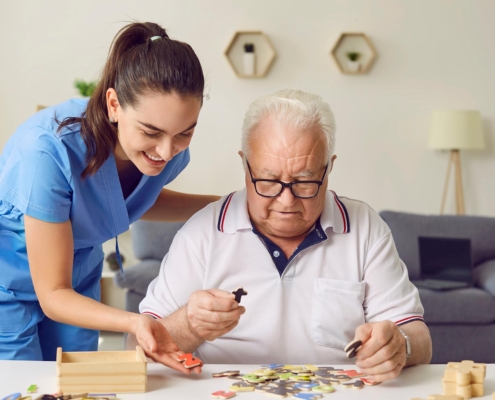 https://www.fairmontseniorliving.com/wp-content/uploads/2025/07/Nurse-or-doctor-give-man-support-during-recovery-or-loss.jpg
1250
2000
Abstrakt Marketing
/wp-content/uploads/2024/11/Fairmont-General-Logo-Color_2000px.png
Abstrakt Marketing2025-07-02 14:07:502025-08-07 21:19:29A Guide to Supporting a Spouse With Memory Loss
https://www.fairmontseniorliving.com/wp-content/uploads/2025/07/Nurse-or-doctor-give-man-support-during-recovery-or-loss.jpg
1250
2000
Abstrakt Marketing
/wp-content/uploads/2024/11/Fairmont-General-Logo-Color_2000px.png
Abstrakt Marketing2025-07-02 14:07:502025-08-07 21:19:29A Guide to Supporting a Spouse With Memory Loss What Is Long Distance Caregiving for Seniors? A Guide
Caring for an aging loved one is always a complex journey—one filled with decisions, emotions, and the constant hope of doing the best for someone you care about deeply. But when you live far away, that journey often becomes even more challenging.
So what is long distance caregiving, exactly? And how can you manage this role effectively while balancing your own life, work, and family? In this guide, we explore the unique realities of long distance caregiving, from definitions and challenges to practical tips and supportive resources.
What Is Long Distance Caregiving for Seniors?
Long distance caregiving refers to providing any kind of care, emotional, financial, logistical, or even coordinating medical care, from afar. There’s no strict mileage requirement, but generally, if you can’t easily be there in person to help at a moment’s notice, you’re considered a long distance caregiver.
What Long Distance Caregivers Do
This role might include:
- Coordinating medical appointments and transportation
- Hiring home health aides or local helpers
- Managing finances, paying bills, or handling insurance paperwork
- Offering emotional support via phone or video call
- Checking in with neighbors or friends to keep an eye on your loved one
- Organizing home repairs or safety improvements
In short, care giving for elderly from a distance often involves being the hub that keeps information, services, and people connected even when you can’t be there in person.
Common Challenges Faced by Long Distance Caregivers
Caring for a loved one from afar brings unique challenges that often catch families off guard. While you may start with optimism and commitment, the realities of distance can quickly create feelings of guilt, worry, and helplessness. Understanding these challenges is the first step toward building a plan that protects both your loved one’s well-being and your own peace of mind.
Emotional and Mental Stress
Caregivers often report feeling:
- Guilty about not being nearby
- Overwhelmed by the uncertainty of their loved one’s day-to-day condition
- Helpless in emergency situations
- Worn out from juggling responsibilities at home and caregiving duties
Communication Hurdles
When you can’t visit regularly, communication gaps can quickly grow:
- It’s hard to see subtle shifts in mood or health
- Other family members may disagree on care plans
- Misunderstandings with local caregivers can happen without regular in-person check-ins
Coordinating Logistics and Care
You might also face the constant challenge of:
- Scheduling medical appointments and transportation from a distance
- Hiring trustworthy, reliable local help
- Navigating insurance and billing issues
- Managing home maintenance or modifications remotely
Financial Considerations
Long distance caregivers often incur additional costs, including:
- Travel expenses to visit and handle emergencies
- Hiring local aides or contractors
- Paying for home safety updates
- Balancing caregiving costs with personal financial responsibilities
Signs You Might Need Extra Long Distance Caregiver Support
It’s normal to want to do it all yourself, but certain signs suggest you may need help:
- You’re constantly anxious, distracted, or losing sleep over caregiving worries
- Your loved one’s needs are growing quickly and feel unmanageable
- You notice breakdowns in communication with other family members or local helpers
- You don’t have clear information about your loved one’s daily routine, medications, or health updates
- Your loved one has experienced recent falls, injuries, or hospitalizations
Recognizing these signals early can help prevent burnout and ensure your loved one stays safe and supported.
Get caregiver tips to avoid common mistakes as a senior caregiver.
Tips and Tools for Managing Long Distance Caregiving
If you’re beginning your journey as a long distance caregiver, you might feel overwhelmed by the uncertainty and logistics ahead. The good news is that with the right tools, habits, and support network, you can ease stress and create a more stable routine for yourself and your loved one.
Here are some practical ways to get started.
Build a Local Support Network
Finding reliable local contacts is one of the most important first steps. This could mean connecting with neighbors, friends, or community volunteers who are willing to check in occasionally and let you know if anything seems out of place. Establishing relationships with nearby helpers gives you peace of mind and another set of eyes on your loved one’s well-being when you can’t be there.
Leverage Technology
Technology has transformed long distance caregiving in recent years. Scheduling regular video chats can help you gauge your loved one’s mood, appearance, and living environment far better than phone calls alone. There are also apps and tools that allow you to track medication schedules, manage health updates, and coordinate appointments with other family members or local caregivers. Incorporating these tools into your routine can bring order and clarity to what often feels chaotic.
Stay Organized
Consistency is crucial when caring from afar. Setting a regular schedule for calls, check-ins with local helpers, and even reminders for paperwork or bills can make a significant difference. Having important documents, like medical records, emergency contacts, and legal papers, in a digital or physical folder you can access quickly is also helpful. Staying organized ensures you’re ready to respond quickly when questions or concerns arise.
Take Care of Yourself
Burnout is one of the greatest risks for any caregiver, but it’s particularly common when you feel isolated or constantly worried about someone far away. Taking breaks, talking to others who understand your role, and maintaining parts of your own life outside of caregiving aren’t luxuries—they’re necessities. Long distance caregiving is a marathon, not a sprint, and protecting your own well-being helps you continue to support your loved one for the long haul.
When to Consider Senior Living Communities
Sometimes, even the best-laid plans become unsustainable. Your loved one’s needs might increase beyond what you can manage from afar. Or maybe the stress of coordinating daily tasks remotely becomes too much.
That’s where senior living communities come in. These communities offer:
- 24/7 professional care and supervision
- Social connection and engaging daily activities
- Safer living spaces designed for older adults
- A support system that keeps families informed and connected
If you’re considering this next step, it’s okay to reach out for help.
Take the Next Step With Fairmont
Caring for an elderly loved one from a distance comes with uncertainty, stress, and difficult decisions. But you don’t have to navigate this path alone. Fairmont Senior Living is here to help you find clarity and peace of mind as you support your loved one from afar.
Our communities provide personalized care, engaging programs, and secure, welcoming environments where residents thrive and families stay connected—no matter the miles between. We understand the challenges of coordinating care remotely and offer regular updates, family communication plans, and compassionate staff who treat every resident like family.
If you’re beginning to explore senior living options or simply want advice on how to better manage long distance caregiving, our team is ready to listen and guide you through the next steps. Contact Fairmont Senior Living today to schedule a tour, ask questions, or learn how we can help you build a safer, more connected future for your loved one. Together, we’ll make sure they receive the support, respect, and care they deserve.
Share This Post
More Like This
 https://www.fairmontseniorliving.com/wp-content/uploads/2025/07/Nurse-or-doctor-give-man-support-during-recovery-or-loss.jpg
1250
2000
Abstrakt Marketing
/wp-content/uploads/2024/11/Fairmont-General-Logo-Color_2000px.png
Abstrakt Marketing2025-07-02 14:07:502025-08-07 21:19:29A Guide to Supporting a Spouse With Memory Loss
https://www.fairmontseniorliving.com/wp-content/uploads/2025/07/Nurse-or-doctor-give-man-support-during-recovery-or-loss.jpg
1250
2000
Abstrakt Marketing
/wp-content/uploads/2024/11/Fairmont-General-Logo-Color_2000px.png
Abstrakt Marketing2025-07-02 14:07:502025-08-07 21:19:29A Guide to Supporting a Spouse With Memory Loss  https://www.fairmontseniorliving.com/wp-content/uploads/2025/06/nurse-doctor-senior-care-caregiver-photo-album.jpg
1250
2000
Abstrakt Marketing
/wp-content/uploads/2024/11/Fairmont-General-Logo-Color_2000px.png
Abstrakt Marketing2025-06-13 14:35:212025-08-07 21:19:30What to Expect in the First 30 Days of Memory Care
https://www.fairmontseniorliving.com/wp-content/uploads/2025/06/nurse-doctor-senior-care-caregiver-photo-album.jpg
1250
2000
Abstrakt Marketing
/wp-content/uploads/2024/11/Fairmont-General-Logo-Color_2000px.png
Abstrakt Marketing2025-06-13 14:35:212025-08-07 21:19:30What to Expect in the First 30 Days of Memory Care https://www.fairmontseniorliving.com/wp-content/uploads/2025/06/A-Memory-Care-Community-Checklist-for-Families.jpg
1250
2000
Abstrakt Marketing
/wp-content/uploads/2024/11/Fairmont-General-Logo-Color_2000px.png
Abstrakt Marketing2025-06-11 18:50:282025-08-07 21:19:30A Memory Care Community Checklist for Families
https://www.fairmontseniorliving.com/wp-content/uploads/2025/06/A-Memory-Care-Community-Checklist-for-Families.jpg
1250
2000
Abstrakt Marketing
/wp-content/uploads/2024/11/Fairmont-General-Logo-Color_2000px.png
Abstrakt Marketing2025-06-11 18:50:282025-08-07 21:19:30A Memory Care Community Checklist for Families https://www.fairmontseniorliving.com/wp-content/uploads/2025/06/Elderly-couple-sitting-on-couch-struggling-to-remember-something.jpg
1250
2000
Abstrakt Marketing
/wp-content/uploads/2024/11/Fairmont-General-Logo-Color_2000px.png
Abstrakt Marketing2025-06-09 17:36:032025-08-07 21:19:31Early Signs of Dementia in Siblings
https://www.fairmontseniorliving.com/wp-content/uploads/2025/06/Elderly-couple-sitting-on-couch-struggling-to-remember-something.jpg
1250
2000
Abstrakt Marketing
/wp-content/uploads/2024/11/Fairmont-General-Logo-Color_2000px.png
Abstrakt Marketing2025-06-09 17:36:032025-08-07 21:19:31Early Signs of Dementia in Siblings  https://www.fairmontseniorliving.com/wp-content/uploads/2025/06/Caretaker-helping-older-couple-with-memory-care.jpg
1250
2000
Abstrakt Marketing
/wp-content/uploads/2024/11/Fairmont-General-Logo-Color_2000px.png
Abstrakt Marketing2025-06-09 16:25:282025-08-07 21:19:31What to Do When Your Spouse Needs Memory Care
https://www.fairmontseniorliving.com/wp-content/uploads/2025/06/Caretaker-helping-older-couple-with-memory-care.jpg
1250
2000
Abstrakt Marketing
/wp-content/uploads/2024/11/Fairmont-General-Logo-Color_2000px.png
Abstrakt Marketing2025-06-09 16:25:282025-08-07 21:19:31What to Do When Your Spouse Needs Memory Care https://www.fairmontseniorliving.com/wp-content/uploads/2025/06/Caretaker-helping-dementia-patient-with-puzzle.jpg
1250
2000
Abstrakt Marketing
/wp-content/uploads/2024/11/Fairmont-General-Logo-Color_2000px.png
Abstrakt Marketing2025-06-09 16:13:212025-08-07 21:19:32What Is Montessori Memory Care? A Guide for Families Navigating Dementia
https://www.fairmontseniorliving.com/wp-content/uploads/2025/06/Caretaker-helping-dementia-patient-with-puzzle.jpg
1250
2000
Abstrakt Marketing
/wp-content/uploads/2024/11/Fairmont-General-Logo-Color_2000px.png
Abstrakt Marketing2025-06-09 16:13:212025-08-07 21:19:32What Is Montessori Memory Care? A Guide for Families Navigating Dementia https://www.fairmontseniorliving.com/wp-content/uploads/2025/04/Elderly-couple-using-laptop-to-have-video-call-with-family.jpg
1250
2000
Abstrakt Marketing
/wp-content/uploads/2024/11/Fairmont-General-Logo-Color_2000px.png
Abstrakt Marketing2025-04-04 17:51:102025-08-07 21:19:32A Guide to Long-Distance Caregiving for Dementia
https://www.fairmontseniorliving.com/wp-content/uploads/2025/04/Elderly-couple-using-laptop-to-have-video-call-with-family.jpg
1250
2000
Abstrakt Marketing
/wp-content/uploads/2024/11/Fairmont-General-Logo-Color_2000px.png
Abstrakt Marketing2025-04-04 17:51:102025-08-07 21:19:32A Guide to Long-Distance Caregiving for Dementia  https://www.fairmontseniorliving.com/wp-content/uploads/2025/04/Two-elderly-adults-playing-word-games-at-table.jpg
1250
2000
Abstrakt Marketing
/wp-content/uploads/2024/11/Fairmont-General-Logo-Color_2000px.png
Abstrakt Marketing2025-04-04 17:35:312025-08-07 21:19:33How to Help Someone Transition Into a Memory Care Community
https://www.fairmontseniorliving.com/wp-content/uploads/2025/04/Two-elderly-adults-playing-word-games-at-table.jpg
1250
2000
Abstrakt Marketing
/wp-content/uploads/2024/11/Fairmont-General-Logo-Color_2000px.png
Abstrakt Marketing2025-04-04 17:35:312025-08-07 21:19:33How to Help Someone Transition Into a Memory Care Community https://www.fairmontseniorliving.com/wp-content/uploads/2025/01/A-Complete-Guide-to-Funding-for-Memory-Care-Services-for-Your-Loved-One.jpg
1250
2000
Paul Cook
/wp-content/uploads/2024/11/Fairmont-General-Logo-Color_2000px.png
Paul Cook2024-07-30 18:32:502025-08-07 21:19:35A Complete Guide to Funding for Memory Care Services for Your Loved One
https://www.fairmontseniorliving.com/wp-content/uploads/2025/01/A-Complete-Guide-to-Funding-for-Memory-Care-Services-for-Your-Loved-One.jpg
1250
2000
Paul Cook
/wp-content/uploads/2024/11/Fairmont-General-Logo-Color_2000px.png
Paul Cook2024-07-30 18:32:502025-08-07 21:19:35A Complete Guide to Funding for Memory Care Services for Your Loved OneOur Communities
Contact Us
Clayton: (314) 646-7600
Farmington Hills: (248) 538-9200
Northville: (734) 420-7917
Washington Township: (937) 438-0054
Westlake: (440) 808-0074

